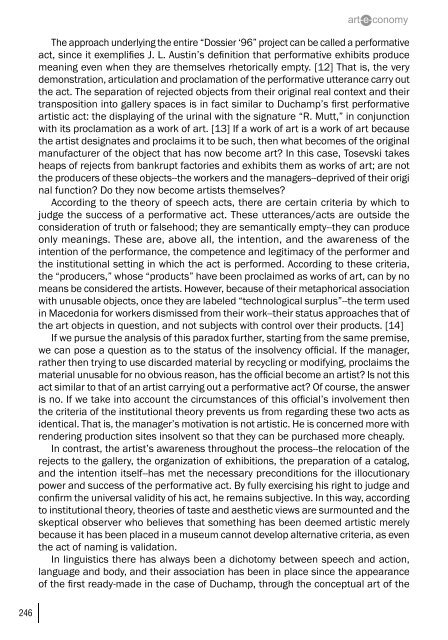art-e-conomy _ reader - marko stamenkovic
art-e-conomy _ reader - marko stamenkovic
art-e-conomy _ reader - marko stamenkovic
You also want an ePaper? Increase the reach of your titles
YUMPU automatically turns print PDFs into web optimized ePapers that Google loves.
246<br />
The approach underlying the entire “Dossier ‘96” project can be called a performative<br />
act, since it exemplifies J. L. Austin’s definition that performative exhibits produce<br />
meaning even when they are themselves rhetorically empty. [12] That is, the very<br />
demonstration, <strong>art</strong>iculation and proclamation of the performative utterance carry out<br />
the act. The separation of rejected objects from their original real context and their<br />
transposition into gallery spaces is in fact similar to Duchamp’s first performative<br />
<strong>art</strong>istic act: the displaying of the urinal with the signature “R. Mutt,” in conjunction<br />
with its proclamation as a work of <strong>art</strong>. [13] If a work of <strong>art</strong> is a work of <strong>art</strong> because<br />
the <strong>art</strong>ist designates and proclaims it to be such, then what becomes of the original<br />
manufacturer of the object that has now become <strong>art</strong>? In this case, Tosevski takes<br />
heaps of rejects from bankrupt factories and exhibits them as works of <strong>art</strong>; are not<br />
the producers of these objects--the workers and the managers--deprived of their origi<br />
nal function? Do they now become <strong>art</strong>ists themselves?<br />
According to the theory of speech acts, there are certain criteria by which to<br />
judge the success of a performative act. These utterances/acts are outside the<br />
consideration of truth or falsehood; they are semantically empty--they can produce<br />
only meanings. These are, above all, the intention, and the awareness of the<br />
intention of the performance, the competence and legitimacy of the performer and<br />
the institutional setting in which the act is performed. According to these criteria,<br />
the “producers,” whose “products” have been proclaimed as works of <strong>art</strong>, can by no<br />
means be considered the <strong>art</strong>ists. However, because of their metaphorical association<br />
with unusable objects, once they are labeled “technological surplus”--the term used<br />
in Macedonia for workers dismissed from their work--their status approaches that of<br />
the <strong>art</strong> objects in question, and not subjects with control over their products. [14]<br />
If we pursue the analysis of this paradox further, st<strong>art</strong>ing from the same premise,<br />
we can pose a question as to the status of the insolvency official. If the manager,<br />
rather then trying to use discarded material by recycling or modifying, proclaims the<br />
material unusable for no obvious reason, has the official become an <strong>art</strong>ist? Is not this<br />
act similar to that of an <strong>art</strong>ist carrying out a performative act? Of course, the answer<br />
is no. If we take into account the circumstances of this official’s involvement then<br />
the criteria of the institutional theory prevents us from regarding these two acts as<br />
identical. That is, the manager’s motivation is not <strong>art</strong>istic. He is concerned more with<br />
rendering production sites insolvent so that they can be purchased more cheaply.<br />
In contrast, the <strong>art</strong>ist’s awareness throughout the process--the relocation of the<br />
rejects to the gallery, the organization of exhibitions, the preparation of a catalog,<br />
and the intention itself--has met the necessary preconditions for the illocutionary<br />
power and success of the performative act. By fully exercising his right to judge and<br />
confirm the universal validity of his act, he remains subjective. In this way, according<br />
to institutional theory, theories of taste and aesthetic views are surmounted and the<br />
skeptical observer who believes that something has been deemed <strong>art</strong>istic merely<br />
because it has been placed in a museum cannot develop alternative criteria, as even<br />
the act of naming is validation.<br />
In linguistics there has always been a dichotomy between speech and action,<br />
language and body, and their association has been in place since the appearance<br />
of the first ready-made in the case of Duchamp, through the conceptual <strong>art</strong> of the


